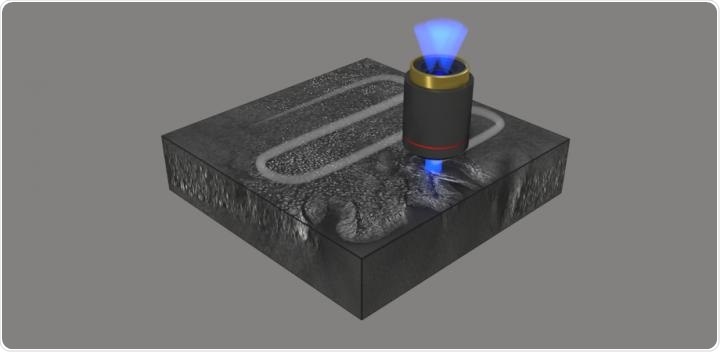Histology involves the investigation of biological tissues at the microscopic level. Histology is also known as microscopic anatomy and is commonly used to diagnose cancer and other diseases.

Schematic of the imaging of pathological tissue 3D structure by combining optical diffraction tomography and automated stitching. Image Credit: Hugonnet et al.
Tissue specimens collected during surgery, for example, can help determine when additional surgical intervention is required, and additional surgery may be eliminated if a diagnosis is obtained quickly during an operation.
Conventional histopathology techniques are usually restricted to thin specimens that necessitate chemical processing of the tissue to offer sufficiently high contrast for imaging, which delays the process. A recent breakthrough in histopathology avoids the need for chemical staining, thereby allowing high-resolution imaging of thick tissue portions.
An international team of researchers recently demonstrated a 3D label-free quantitative phase imaging method that involves using optical diffraction tomography to acquire volumetric imaging data. The study findings have been reported in Advanced Photonics. In this method, automated stitching makes image acquisition and analysis easier.
Optical diffraction tomography
Optical diffraction tomography is a microscopy method that reconstructs a tissue sample’s refractive index from scattered field images collected at different illumination angles. It allows the visualization of transparent samples with high contrast without the use of labels.
First, the complex scattered field transmitted through the sample is extracted using off-axis holography, following which the scattered fields acquired with different angles of illumination are plotted in Fourier space, thus allowing the sample refractive index to be reconstructed.
The complex distribution of refractive indexes causes severe optical aberration in the imaging of dense tissue, which is a well-known drawback of optical diffraction tomography.
To address this drawback, the researchers used digital refocusing and automated stitching to allow volumetric imaging of 100-mm-thick tissues over a lateral field of view measuring 2 mm × 1.75 mm while retaining a high resolution of 170 nm × 170 nm × 1400 nm.
The researchers showed that high resolution combined with a large field of view enables simultaneous visualization of mesoscopic and subcellular structures in various tissues.
Fast, accurate histopathology
The researchers showed the capability of their innovative technique by imaging a range of different cancer pathologies, including pancreatic neuroendocrine tumor, bile duct intraductal papillary neoplasm, and intraepithelial neoplasia.
They visualized millimeter-scale, unstained, 100-μm-thick tissues at a subcellular 3D resolution, which allowed them to see individual cells and multicellular tissue structures similar to conventional chemically processed tissues.
The images obtained with the proposed method enabled clear visualization of different morphological features in the various tissues allowing for recognition and diagnosis of precursor lesions and pathologies.”
YongKuen Park, Study Senior Author and Researcher, Korea Advanced Institute of Science and Technology
Park points out that further study is required, but the findings indicate a great potential for precise, fast histopathology during surgery.
More research is needed on sample preparation, reconstruction speed, and mitigation of multiple scattering. We expect optical diffraction tomography to provide faster and more precise diagnostics in histopathology and intraoperative pathology consultations.”
YongKuen Park, Study Senior Author and Researcher, Korea Advanced Institute of Science and Technology
Source:
Journal reference:
Hugonnet, H., et al. (2021) Multiscale label-free volumetric holographic histopathology of thick-tissue slides with subcellular resolution. Advanced Photonics. doi.org/10.1117/1.AP.3.2.026004.